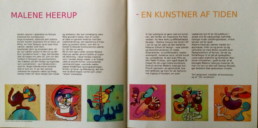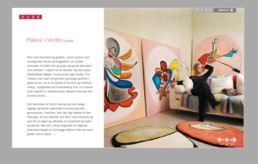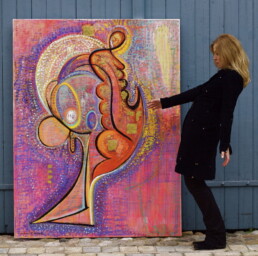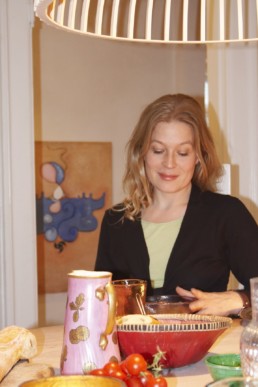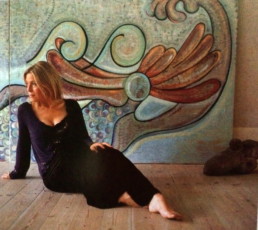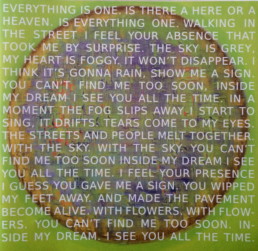Selected
Further Reading
Process:
Musicians compose on instruments, as visual artists often create new compositions by drawing, often in a
meditative state. I create series based on concepts of outer and inner experiences, processed inside me, coming out spontaneously on paper or on canvas. I sometimes sketch a series on paper, make preparatory drawings, and then transfer those ideas to canvas. I choose the design ideas that I have a strong urge to explore further or memorialize in a larger scale.
This process can also lead to ideas for design used in everything from applied art to scenography (room design).
I use oil painting in many applications, layer after layer to create depth in the colors and form. I like to create textures in all kinds of materials and techniques. Experimentation with a focus on the line, drawing, movement, the strokes, form and back again to the lines. I am inspired by textures of stone, granite, velvet, the plant kingdom and its colors, silk, cotton, metal, and how the light falls on and interacts with these various surfaces. Natural living forms are always inspiring me.
I paint on paper with mixed media from ink to gouache, watercolor acrylics, pigment, oil-sticks etc. On canvas I use oil painting, including oil-sticks and sometimes spray paint and apply metal leaf. I Look for contrasts and celebrations of color and texture light and depth in my compositions.
Living in Northern Europe I often draw when the sun is down, and paint with the natural light constantly changing all day, and even hour to hour. The light here is dramatic and unpredictable. The presence of the light or the nature of it impacts my emotional self. I pay attention to those moods shifts and permit them to inspire me.
There is a magic for me to work daily with colors and textures. I shape them as a sculpture shapes denser media with greater mass. The layers and lines will bring out forms. Images emerge and concepts come alive in the process.
I quiet myself and invite my subconscious feelings to emerge and become a visual voice with no control or prejudgement of what will be revealed. I search for the complete aesthetic statement. The result will come after a long process where I find a way to reconnect and create an image that the viewer can feel, and perhaps want to touch
Inspirations & Influences:
Creations from the roots of human ancient expression and symbolism, over Egyptian art and architecture, the Mayans in Mexico, up to modern times. Surrealism, all the isms, modern art, to pop and street art.
Oriental art and aesthetics of all times have always been a big inspiration, and the zen approach to personal expression. The old masters would for example look at a landscape, a place , a scenario, person, etc. and after really seeing the essence start the art process. They would proceed with what was captured by the inner eye after having really gotten to “know”, and processed, and looked at something deeply, and then render it on paper or canvas. I want to see, sense and express something complex in a “simple” way.
Influenced by:
- Art, everything visually and emotionally stimulating
- Design
- Architecture
- Photography
- Contemporary Japanese Graphic design, Design, Fashion
- Music
- Movies
- Poetry
- Places, now and before, (traveling in times with imagination)
- Current events
- History and art history
I lived in NYC during the 1990s where I studied at Parsons School of Design, and also for shorter periods in the 80’s.
I loved the melting pot of the whole world being represented there, also in the museums, galleries and in the streets. In the freedom that everybody was influenced by everybody – in the street art, the street fashion, the art scene, the music scene – a dialogue between the arts using each other for collaborations and inspiration.
I have myself participated in many collaborative projects in theatre, music and design.
I have lived for longer periods in Paris, London, Belgium, and travelled in places like India, Mexico and Kenya.
Being away from my roots somehow adds to the inner universe from where my artwork takes form.
I am a woman, but human first.
Good art, for me, is engaged in dialogue with its time. Engaged with other artists in all media. I love to live in this timeless dialogue. I see sensuality, humour, and poetry everywhere in form, color, textures and just being around people and life as it is, with all its mystery and symbolism.
Biography, family:
Born in an artist family, 3 generations, raised in Copenhagen.
My grandparents on my fathers side Henry Heerup (painter, sculpture) and Mille Heerup (abstract gobelin weaver) met at the Danish Royal Art Academy in Copenhagen. My father Ole Heerup (painter) went to the same Art Academy, later.
My aunt, Nana Hertoft, is an abstract gobelin weaver.
They taught me a lot, and have been a huge inspiration. Growing up I was around people on both sides of my family working in all the art forms in a very creative and lively passionate upbringing.
Since I was a child, as far back as I can remember, I have had a pencil or brush in my hand. I learned very early how to use a Japanese calligraphy pen and was taught how to draw by my grandmother. She taught at the Danish Design School in Copenhagen for 25 years aside from being an artist.
Life in an artistic family is like being home schooled. I learned from being an observant kid, and in interaction with my family of artists working in different media.
The art of living and looking for the possibilities and going deep into the creative process was as normal for us as making dinner. I had a huge imagination, and inner life, and I felt naturally that the only thing in the world for me, was to become an artist.
Malene Heerup – Artist of the time
A profile byTom Jørgensen, editor of ‘Kunstavisen’, (The Art paper) editor of ‘101 Kunstnere’ (101 Artists, Contemporary art). June 2011, Copenhagen.
The world is currently experiencing a renewed interest in surrealism.
Young artist, nationally and internationally inspired from a Miro, a Yves Tanguys and Jean Arps works, think about them, process them, and transform them so that the new works match the time and spirit, that the artist live today.
It is not so much about the exterior style, but about the celebration of imagination and spontaneity, it draws on the lush and organic, as with surrealism – and the art that Cobra- stood for. Something the visual arts are certainly not alone about. We see the same interest for organic growth and fertile imagination within design as well as fashion and architecture. There may of course be several reasons for this, but one seems to be a general reluctance to the system-thinking, the ignoring of the body and psyches needs that the rationally motivated functionalism degenerating into, when it is worst.
In her own way Malene Heerup captures this spirit of the time in her works, this organic thinking. In both her paintings in her designs, we meet a rich abundance of amorphous forms, surprising juxtapositions, unexpected meetings, funny stories, and body firings, told in a colour and imagery that is steeped in both tropical heat as urban “street” mentality. We obviously have to do with an artist who draws inspiration from around the world, from New York’s graffiti coated facades – Malene Heerup have lived in NY for seven years and has gone to the famous Parsons School of Design – over plant – and the floral world to fashion illustrations, crafts, theatre set design, modern dance, ethnic arts and inevitably, to the Juan Miro and Pablo Picasso, who also meant so much for the young Cobra artists.
Everywhere in her work Malene Heerups philosophy of life shines clearly through, an optimistic and above all humorous approach to art, there is an overwhelming desire to reach audiences in another way than you find in the usual white self important exhibition rooms that we all know too well.
Malene Heerups works confront us in eye level tease and excites us and challenge us with their visual cornucopia of shapes, colours and stories to explore our own dreams and fantasies. You simply get in a good mood by looking at Malene Heerups works. The fact that you can see them now at the Heerup Museum certainly does not make the experience less.
The third play: Malene Heerup
Artworks revealed against the walls of an exhibition space extend the boundaries and conceptions of an “artwork”. The “now” is it and “it” is all an infinite”. Even the notion of two-dimensional confronting heterogenic surfaces is considered a three-dimensional and transcendental transit of corresponding and pregnant matters to Malene Heerup, who exerts this among other elements in the exhibition “The Third Place”.
The ontology of jazz music and improvising is equally prudent to Malene Heerup: “The first recorded act, paint stroke or walking step is virtue and superior and it conducts the latter. Selective reconstructions and improvements to perfect and support elite assumptions of an accurate aesthetic precision are transparent and frail. A commutative space of the significant and instantaneously conceived artwork with interconnected links for spontaneous reception is conceived.”
The idolized Danish architect Arne Jacobsen’s (1902-1971) wooden chair, “The Ant” (Myren), is evident in this scenario. It is drawn into Malene Heerup’s massive body of extrovert, colourful and dynamic works, which forms a peculiar but poetic and humorous sphere, in which it is articulated and exhibited. The Ant carries Malene Heerup’s delicately engraved Heerup art-family strains of easily recognizable iconic layers, which travel hand in hand with its geographic origin and art historical references.
Not surprisingly and on several occasions has Malene Heerup been referred to as a contemporary surrealist. Not in a Bretonian sense or as if Malene Heerup’s works are to be juxtaposed with the orthodox Surrealist movement, which relates strictly to psychoanalysts Jung and Freud and the earlier metaphysics, Chirico often included. The visual expression of Malene Heerup, performs more in the “surreal” tradition of the French-German Dadaist Jean Arp. Malene Heerup possess, as Arp, a great passion and interest in “the sculptural qualities of the painted motif”, which is noticeable apparent in Malene Heerup’s painting “Sending a Ball”.
Apart form the central motifs forceful puberty and profoundly conducted, agile gesture, it also draws a set of references into the sculptural and organic visual language of Arpean abstraction and the 1950-60s Hepworth, Moore & prior Bancusi. Elements of early modern painting, counting in Paul Klee, Kandinsky and Miro as well, can be witnessed in “Sending a Ball”, in its temperament, colours and demonstration of highly controlled and skilled painting techniques. ”Lead Singer in ‘Ballet B de la C”’ additionally mesmerizes. When this is mentioned, it is not to be mistaken for that Malene Heerup urges to recreate an art form of the past.
What is attended and what comes into action is the artists ability to extract various components of painting traditions from different historical periods and emphasize, what is remarkable about them, while simultaneously incorporating them into present art forms, where to reflect upon, how artworks significantly configures and extend, cohere and exchanges, depending on culture, social and historical circumstances and the conditions and positioning of the spectator, naturally.
In this effort Malene Heerup also cites the accumulating iconographical continuum of her ancestors, the Heerup artist family of painters among other artists in the family, and especially grandfather and international known artist Henry Heerup (1907-1993), in a vividly conscious, challenging and scrutinizing way, exquisite, coy and confined. This is apparent in the complex, meta-cultural stratum, which Malene Herrup transfers to any imaginable surface: canvases, furniture, walls etc., as a personal mark and signature. Whereas the foci among visual artists of today from the early 1980s and ahead is characterized and dominated by the manufacting of art products, which is tailored to please mercantile demands of liberalistic Western capitalism and to be commissioned, launched and promoted by professional agents through art fairs, biennales and galleries, as art stocks and art shares for investors, Malene Heerup’s clearly unique, outstanding and autonomous – institutionally emancipated and independent personal attitude jumps into mind, as a harsh reminder of what the conceptions of Modernity actually stands for.
The intensity and force drawing you into the locations of Gallery Copenhagen is overwhelming. It is an avalanche of colours that makes you squint and wish you’d brought your sunglasses. Don’t get me wrong…I love sunshine and bright colours especially when the weather outside is rainy and grey.
If you participate in this enchanted tour you will most probably get a variety of experiences – like we all experience the world in a variety of ways. The tour takes you to colourful India with all it’s fables. You’ll go to vibrant Italy with their inviting cousine. The carm of Greece with it’s heady seas. And not least, sunny Egypt and it’s magnificent pyramid sights.
And then again. Taking in Malene Heerups works once again you could find yourself in a fairytale by H.C.Andersen – or imagination allowing, a whole different place.
Now don’t concentrate only on the motives. These are a small and flighty part of the paintings. It is the colour scheme that sets Malene apart. Malene is working with colours. Lots of colours. And contrasts. It is the calm in her work despite the exploding colours, that makes he work so incredible.
In this exhibition you detects Malenes couriosity and passion for experiments. The works are more than only paintings. World famous design effects like Arne Jacobsene chair “The Ant” and Montana bookcases becomes works of art in Malenes hands. Her most recent outdoor wallpainting is also represented and truly worth a visit.
Most of all you sense the love. The feelings are let loose to tickle your senses. It is living art and eventhough this is oilpaint and hard canvas you sense the smoothness of velvet.
If you like your senses to come alive and get the experience of sunshine in your heart this exhibition would be a fantastic choice. Whether you like the fables and mystique of India or the fairytales of H.C.Andersen. It is up to your imagination, senses and what your eyes are seeing.
Malene Heerup – SENTIENT SOPHISTICATED
Malene Heerup works with painting, but always sees its expression as a part of the room she is in. The works must move something, it must interact with the present space. Therefore the works float out – out on the floor as carpets, they crawl in through the camera lens and comes out again as photostats, jumps up on a chair or on a shelf and challenge already welldefined items. The interaction sharpens the viewer’s senses and one can almost feel the movement in the body from the shapes on the canvas, taste the sour in the bright green color – well, almost hear the jazz flows out. As with Kandinsky, Klee and Arp, Malene Heerups works are in a much larger context than their two dimensional reality.
Malene Heerup translates naturally into the elite of artists who know how to see art in a larger context. Her international format was manifested in 1994 when she completed her training at the famous school Parsons School of Design in New York. The school known for fostering large world-renowned artists such as painters Jasper Johns and Edward Hopper. But also interdisciplinary and more uncompromising artists like designers Donna Karan and Marc Jacobs has Parsons as creative foundation.
Heerup is a modern Gesamtkunstwerker. She thinks big thoughts outside the box and broaden the context for her works, so her paintings in addition to being wall decoration also serves as incooperated backgrounds for movies such as the Emmy Award winner Nikolaj and Julie (Danish TV series). Or when Heerups works move from floor to wall or from canvas to shelves, as you can see it in her wonderful collaboration with the Danish-based international furniture manufacturer, Montana. Movement and innovation is reflected not only in the forms playfull easiness but is also reflected in the unconventional way Malene builds on tradition furniture classics, such as when she worked on one of the world famous Danish architect Arne Jacobsen’s iconic chairs ‘ The Ant’.
“The Ant” was lifted out of its function, made into a sculptural color composition, and hung on the wall.
Malene is a highly sought after artist and has appeared in several leading fashion and lifestyle magazines, including the Japanese ESQUIRE MAGASINE og MADAME FIGARO, the Chinese design and housing magazine ANIJA and several leading Danish department stores, including BO BEDRE og EUROWOMAN. BO and EUROWOMAN. Heerup has participated in several international exhibitions including Belgium, Japan and New York.
Malene Heerups art inscribes itself among the best in the world. Her works speaks the universal language of worldclass art and stirs most of the viewer’s senses. Because Malene Heerups works touches you during, and especially after, your meeting with them, she has been named Artist of the Year in 2006 and 2007 respectively by Siemens and The Danish Cancer Society.
Malene Heerup comes from the very famous Danish Heerup family, which include grandfather and COBRA artist Henry Heerup, one of her great artistic role models. She has though created her own artistic path and have always shaped her work within her own sphere. Malene has kept the threads from the old Heerup by poetic and whimsical little wrinkles deeply rooted in organic forms and her tremendous love for the colors. As with Henry Heerup she keeps alive the democratic project – art to the people – but adds new layers to the idea. She works consciously to expand the space between work and viewer, and has the incredible ability to create a third place where space, art and man equally meet.
Kunst kommer af stimulering og skal være stimulerende for beskuerens intellekt og sanser. Et nøgleord er kommunikation. At skabe dialog. At skabe rum. Ifølge kunstneren Malene Heerup er rum ikke alene noget tredimensionalt, men også todimensionale flader skaber i deres indbyrdes kommunikation rum. Gallery Pfeister udstiller netop Malene Heerups værker så begge dele – kommunikation og rum – inkorporeres og kommer i spil.
Dialogen mellem værkerne, rummet og beskueren åbner for erkendelse og sansning. Kunsten bliver en skabende kraft uden egentlig motiv og netop værkernes abstraktion forstærker den sanselige og umiddelbare oplevelse i deres samspil. I galleriet på Sct. Jørgensgade i Gudhjem korresponderer Malene Heerups værker på tværs af deres respektive genremæssige forskellighed. Arne Jacobsens stol myren er fx blevet malet og inddraget i Malene Heerups værkkorpus med dets helt særegne, poetiske, men humoristiske univers. Væsentligst i forbindelse med myren er, at stolens funktion er blevet forskudt. Den er ikke længere brugbar som siddegenstand, hvilket understreges af stolens placering på væggen. Den direkte følge deraf bliver, at stolens kunstneriske værdi eller æstetiske udtryk bliver eksponeret frem for myrens egentlig brugsværdi. Denne forskydning af funktionen og tilføjelse af værkets nye funktion i rummet er en af de centrale ting i udstillingen på Gallery Pfeister; en idé, der arbejder godt sammen med Malene Heerups værker.
At rummet bliver inddraget som en aktiv medspiller i præsentationen af værkerne skal ikke forveksles med den kontemporære kunstscenes installatoriske udtryk, men er måske snarere en moderne variant af Gesamtkunstwerktraditionen, eller som Malene Heerup selv foretrækker at kalde det rumkunst. De hvide flader – vægge, gulve og lofter – i galleriets to små rum bliver på den måde at betragte som et uspoleret hvidt lærred. Pludselig danner gulvet baggrund for et af de små tæppers form, hvorved gulvet og tæppet i deres indbyrdes samspil transformeres til en slags maleri. Værkerne arbejder tydeligt sammen og udgør i deres fragmenterede enheder mere end en helhed.
Dialogen, der opstår, foregår ikke alene internt værkerne imellem eller mellem værk og beskuer, men kommunikerer også med historiske kunstudtryk og -epoker. Det er således heller ikke første gang, Malene Heerup er blevet kaldt en moderne surrealist. Ikke i Bretonsk forstand eller sådan at forstå, at hendes værker er at sidestille med værker fra den litterære surrealistiske bevægelse, der meget konkret forholder sig til de to psykoanalytikerne Freud og Jung. Malene Heerups værker, derimod, optræder snarere i forlængelse af den fransk-tyske surrealist og dadaist Jean Arp. Malene Heerup har, som Arp, en stor interesse og forkærlighed for det skulpturelle i maleriernes figurer, hvilket bl.a. ses i maleriet Descending a ball, der udover figurernes egen friskhed og humor, trækker veksler på det skulpturelle udtryk og organisk-abstrakte formsprog i den Arpske surrealisme. Andre elementer fra den historiske kunsttradition kan fornemmes i værkets farvestemning, der emmer af Paul Klees og Wassily Kandinskys ditto. Når det er sagt, er der dog på ingen måde tale om, at Malene Heerup prøver at genskabe kunsten fra en tabt fortid. Det, der derimod er på færde og som kommer til udtryk i værkerne, er kunstnerens evne til at fremdrage elementer fra forskellige kunsthistoriske epoker og disses udtryk, og indskrive dem i vores nutid i en understregning af, hvorledes kunstværkernes betydning opstår, forskyder sig og indgår i nye sammenhænge, afhængig af sociale og historiske situationer og beskuerens placering heri.
Det er da også via denne forholden sig til fortiden i nutiden, at den særlige oplevelse i forbindelse med Malene Heerups værker opstår. En oplevelse, der opstår midt i mellem værk, rum og beskuer i et erkendelsesrum, som den franske kunstteoretiker og filosof Roland Barthes, har benævnt den tredje mening. Barthes gør en længere ekskurs omkring at erkende og verbalisere kunstoplevelsen, og en af hans væsentlige pointer er, at det netop er svært at sætte ord på en oplevelse af æstetisk karakter. En kunstoplevelse tilhører som bekendt hverken rummet, hvori værkerne befinder sig, ej heller kan den determineres til udelukkende at eksistere i beskuerens bevidsthed eller sind. Oplevelsen kan bestemmes til at være noget midt i mellem, en sansning eller oplevelse, der opstår midt imellem og som er indbegrebet af en evig vekselvirkning mellem værk og beskuer. Den tredje mening er måske er lettere at få hold omkring, hvis man fremskriver den til det tredje sted. Gallery Pfeister fanger netop dette tredje sted i sin ophængning, og understreger samtidig det kommunikative rum, der immanent er til stede i Malene Heerups værker.







